Understanding this rare disease
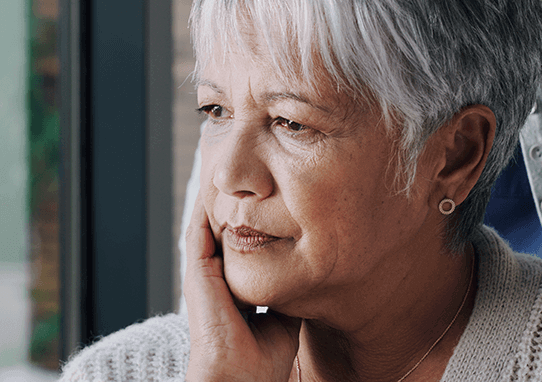
Because desmoid tumors are rare and may not be top of mind for physicians, trying to learn about your condition can be confusing.
One website may tell you one thing or refer to a desmoid tumor in a certain way, while another, or even your doctor, may refer to it in a completely different way. Always speak with your doctor if you have questions.
There is potential for desmoid tumors to be misdiagnosed as another disease. Common misdiagnoses include:1-3,*
- Overgrown scars (like hypertrophic scars or keloids)
- Different cancer types (like low-grade sarcomas or gastrointestinal stromal tumor (GIST))
- Noncancerous growths (like nodular fasciitis, lipoma, fibroma, schwannoma, or leiomyoma)
It’s completely normal for these words to be unfamiliar. Talking about a rare disease can feel like learning a new language. If you’re ever confused about a term, it’s a good idea to ask your doctor to explain it.
From market research conducted by SpringWorks Therapeutics.
A tumor is an abnormal mass of tissue. It forms when cells grow and divide more than they should or don’t die when they should.4
Desmoid tumors may develop in the soft tissues that connect, support, and surround other body parts (connective tissue). Connective tissue is found all throughout the body. That’s why desmoid tumors can grow anywhere in the body. Desmoid tumors are also sometimes called desmoid fibromatosis.5, 7-10
Desmoid tumors are very rare
ABOUT
of soft tissue tumors are desmoid tumors10,11
Doctor Discussion Guide
Who gets desmoid tumors?

There are approximately 1000 to 1650 annual cases in the United States12-14

Most patients are diagnosed between 20 and 44 years of age13

Women are approximately 2 to 3 times more likely than men to be diagnosed2,13,15

Recent pregnancy, injury, or surgery may increase risk of developing a desmoid tumor16,17

Patients with a family history of familial adenomatous polyposis (FAP) have an approximately 850-fold higher risk of developing desmoid tumors than the general population18 What is FAP?
What is familial adenomatous polyposis (FAP)?
FAP is a medical syndrome that can cause polyps (growths) in the colon to become cancerous.10
FAP is an inherited syndrome. This means that an abnormal gene has been passed to a person’s DNA from a parent. The abnormal gene behind FAP is known as APC (adenomatous polyposis coli).10
Having FAP can increase a person’s risk for developing desmoid tumors. Most often, desmoid tumors in people with FAP occur in abdominal locations.15
Doctors who diagnose desmoid tumors will want to know about any family history of FAP. A genetic test for FAP may be recommended for people who have a desmoid tumor.19,20
Sometimes, it’s recommended that people with FAP have a colectomy (surgery to remove the colon) as a way to prevent colon cancer. For some patients, this procedure can increase risk for desmoid tumors developing in the future.10
For more information about FAP or if you have additional questions, please ask your doctor.
Desmoid Tumors: Symptoms
A desmoid tumor and its “tendril-like” growths may wrap around surrounding tissues or structures in the body. This may cause different physical symptoms and pain that can affect daily life.10,21 Symptoms may be different for each person depending on the location of the tumor.22
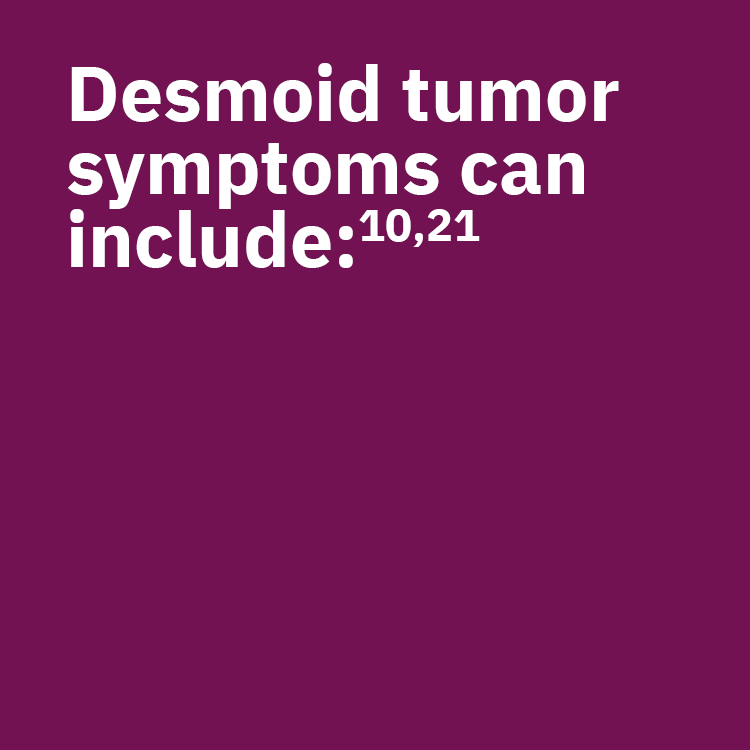
Although desmoid tumors do not spread to other parts of the body, they are often described as “locally aggressive” or “invasive”.10,22 That’s because as the tumors grow, they can put pressure on nearby blood vessels and nerves, or on important organs like your intestines or lungs.6,10 For some, a desmoid tumor may be life-threatening—depending on tumor size, where and how it grows, and the person’s overall health.7,9
Living with a desmoid tumor
Learn more about the Desmoid Tumor Ally Educational Program
Desmoid tumors can show up in different places
It’s difficult to predict where and how desmoid tumors can occur in your body. And each location can have different symptoms associated with it. For some people, the pain and symptom burden can lead to anxiety and depression.21,26 Other people frequently report concern around altered appearance, nerve pain, and decreased range of motion. Quality of life can be impacted by fear, difficulty sleeping, and apprehension about a lack of knowledge among healthcare professionals.21

“I feel largely impacted on a day to day basis. Living from scan to scan is more of a mental and emotional journey.”
Andrea, a real person living with a desmoid tumor
Different tumor locations can lead to different symptoms
Because each tumor is unique, the symptoms and burdens that come with it can be just as unique.
Locations
Estimated Frequency
Potential Symptoms and Complications
Intra-abdominal(including the mesentery, a layer of tissue surrounding and supporting the intestines) 10,27
20%
Blockage of the intestines, ureters, or arteries in the digestive system, pain, muscle wasting and weight loss, malaise (general discomfort), or abdominal swelling10,27,28
NOTE: The mesentery is a continuous set of tissues located in your abdomen. It attaches your intestines to the wall of your abdomen and holds them in place29
Click to view scan
Intra-abdominal desmoid tumor36
This scan shows the desmoid tumor, in the center indicated by a white arrow. The desmoid tumor is surrounding a large blood vessel (white arrowhead). The tumor’s multiple tendrils are extending and threatening the bowel.
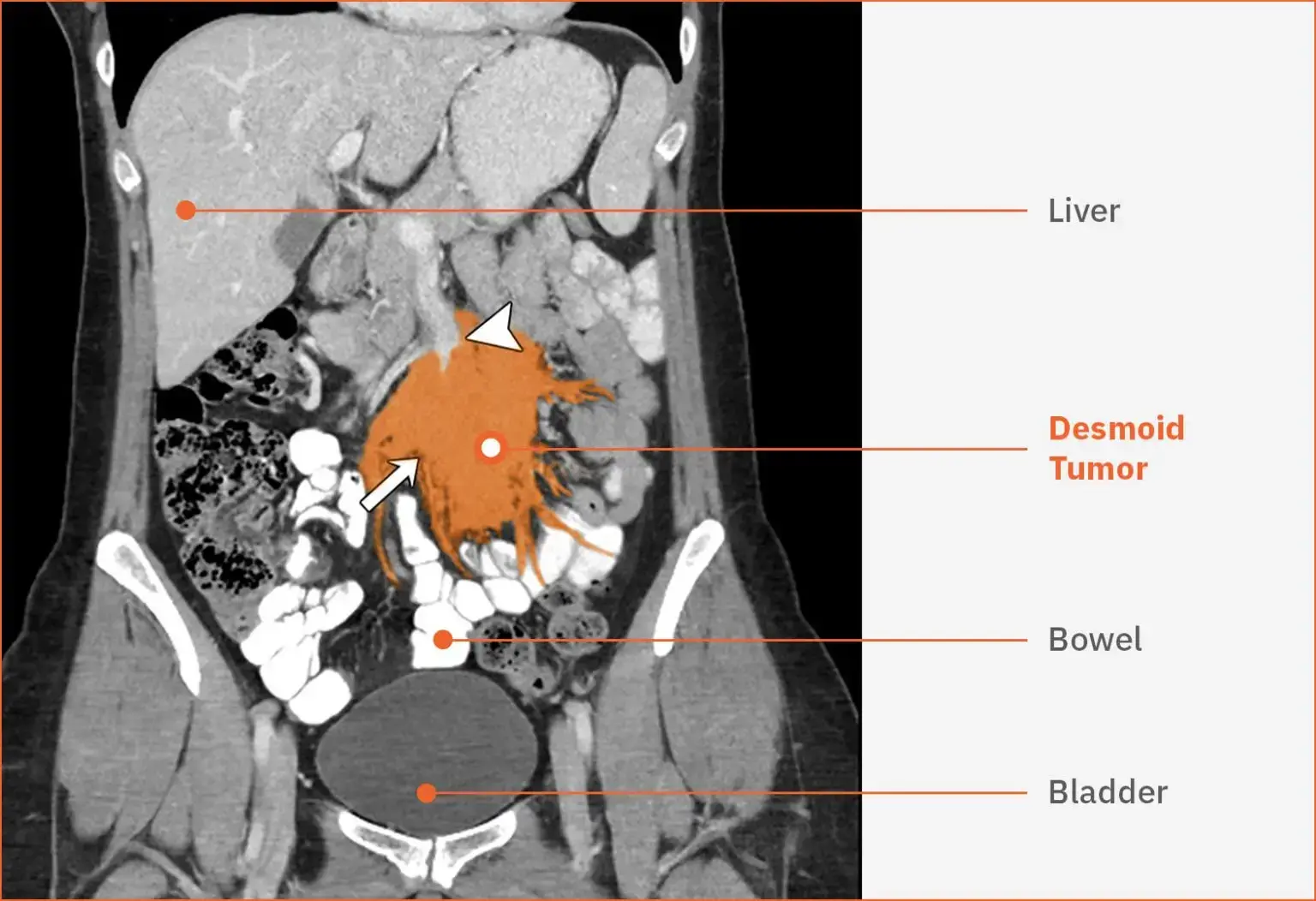
Abdominal Wall
16%
Large tumors may cause skin stretching and compress the bowel or bladder10,30
Desmoid tumors in the leg36
This scan shows multiple desmoid tumors in the lower leg. The white arrows point to the tumors in the calf area.
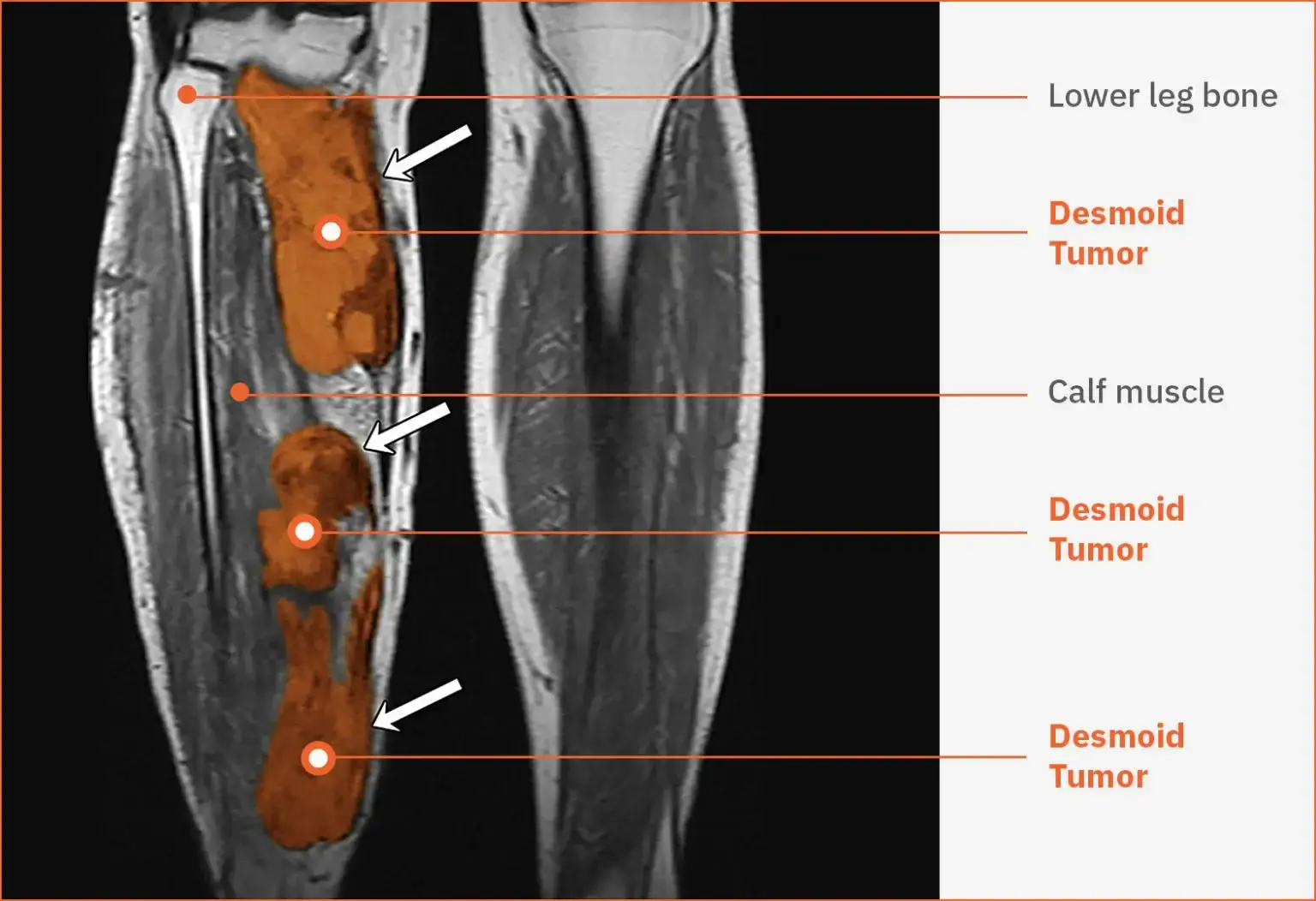
Chest
15%
Shortness of breath, difficulty swallowing, infiltration of the membranes surrounding the lungs, rib or spinal involvement, bone erosion, or pain10,27,32,33
Arms and Hands
14%
Restricted movement, pain, muscle and ligament involvement, limb weakness, or deformity10,34
Click to view scan
Desmoid tumor in the upper arm36
In this scan, the white arrow points to the desmoid tumor in the area of the tricep muscle.
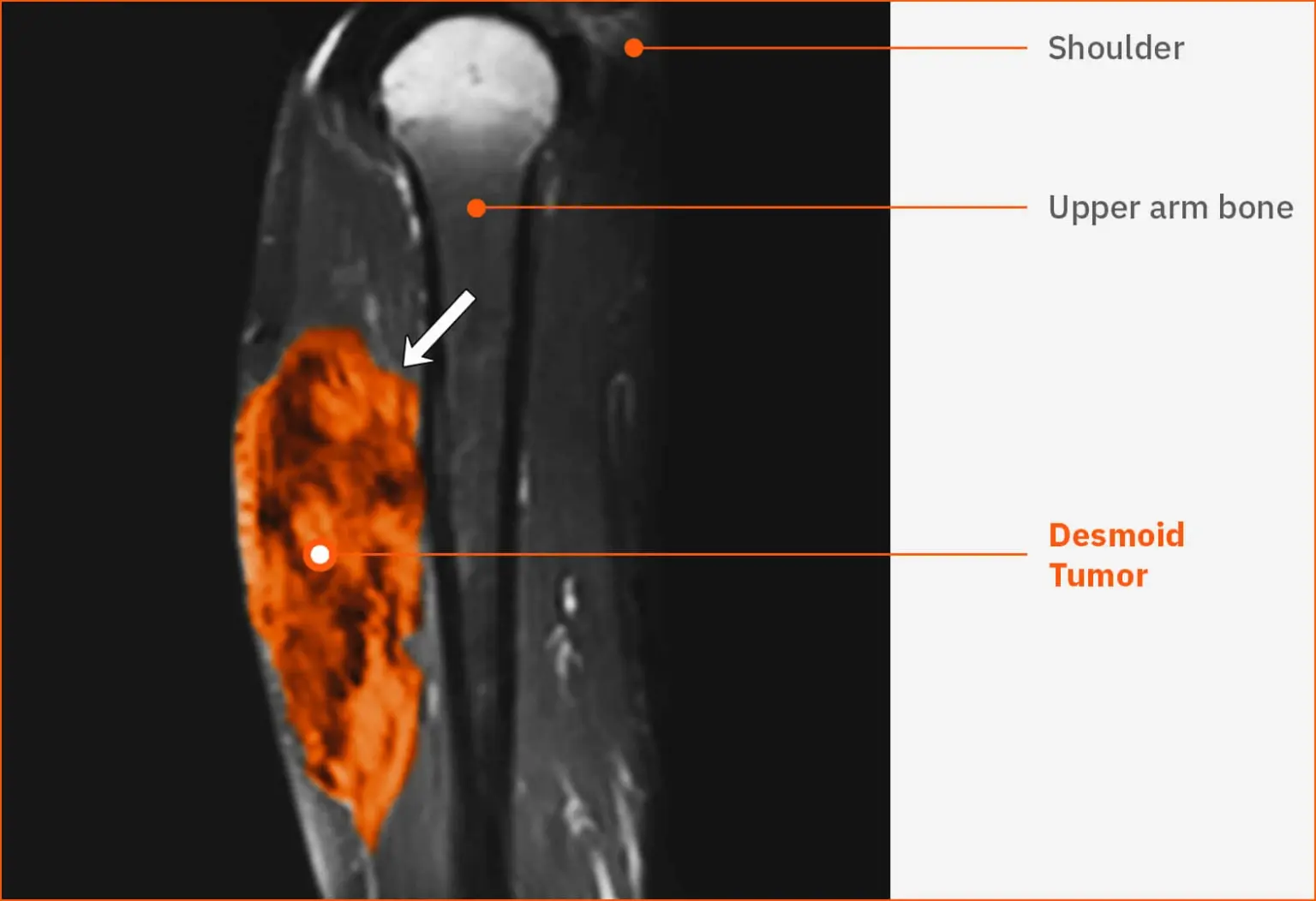
Head and Neck
8%
Pain, neurologic deficit, wrapping and restriction of vital structures like the airway or blood vessels that can become life-threatening7,10,35
Click to view scan
Desmoid tumor in the neck36
In this scan, the white arrow points to the desmoid tumor in the lower neck and throat. The arrowhead shows where the tumor is extending into the spine.
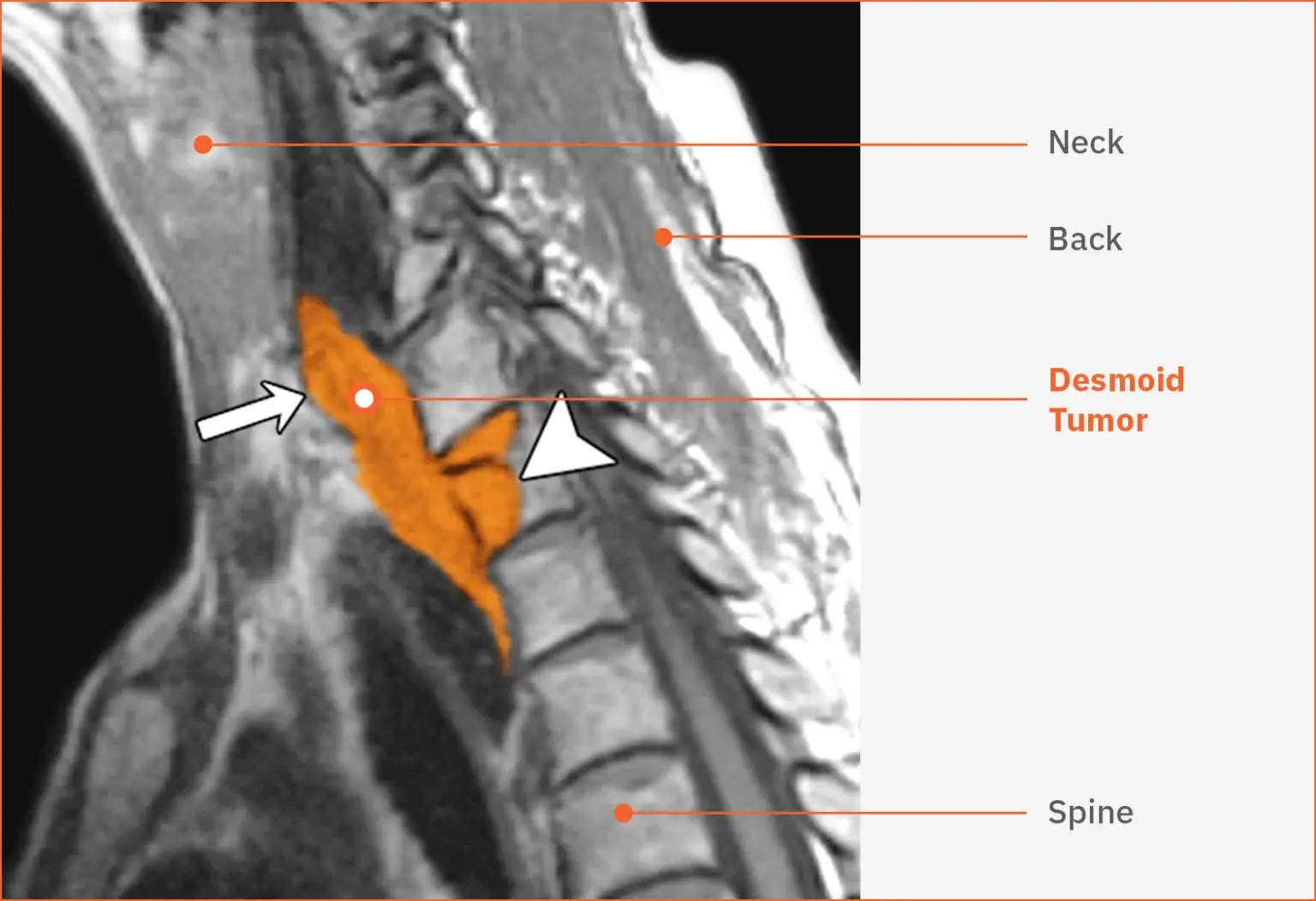
Other
11%
Symptoms and complications are dependent on the tumor location9,10,21
Keep track of your symptoms
It’s helpful to regularly track your symptoms and other health information. Sharing the details with your care team can help them see your progress—and if any changes are needed in your care plan.
- Health apps are available on your smart phone such as Apple Health™
- WebMD® also offers a tracking feature called Symptom Checker
These applications are provided for informational purposes only and do not represent an endorsement or a recommendation from SpringWorks Therapeutics, Inc. The applications listed are independent of SpringWorks and SpringWorks has no control over the content of these applications. The applications are linked to other websites that have different terms of use and privacy policies. Please refer to those applications and websites for the applicable terms of use and privacy policies.
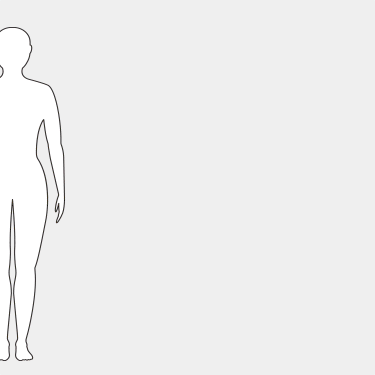
There can be a lot of uncertainty when it comes to having desmoid tumors. Having the right care team by your side can help you feel more confident about your journey and the treatment decisions you make together.
- Data on file. SpringWorks Therapeutics.
- Penel N, Coindre JM, Bonvalot S, et al. Management of desmoid tumours: a nationwide survey of labelled reference centre networks in France. Eur J Cancer. 2016;58:90-96.
- Huss S, Nehles J, Binot E, Wardelmann E, et al. b-Catenin (CTNNB1) mutations and clinicopathological features of mesenteric desmoid-type fibromatosis. Histopathology. 2013;62:294-304. doi:10.1111/j.1365-2559.2012.04355.x
- NIH. National Cancer Institute. NCI dictionary of cancer terms: tumor. Accessed June 24, 2024. https://www.cancer.gov/publications/dictionaries/cancer-terms/def/tumor.
- NIH. National Cancer Institute Center for Cancer Research. Desmoid tumor. Accessed June 24, 2024. https://www.cancer.gov/pediatric-adult-rare-tumor/rare-tumors/rare-soft-tissue-tumors/desmoid-tumor.
- Cancer.Net. Desmoid tumor: symptoms and signs. Accessed May 29, 2024. https://www.cancer.net/cancer-types/desmoidtumor/symptoms-and-signs.
- Penel N, Chibon F, Salas S. Adult desmoid tumors: biology, management and ongoing trials. Curr Opin Oncol. 2017;29(4):268-274.
- Kasper B, Baldini EH, Bonvalot S, et al; Desmoid Tumor Working Group. Current management of desmoid tumors: a review [supplementary online content]. JAMA Oncol. Accessed June 24, 2024. https://jamanetwork.com/journals/jamaoncology/article-abstract/2820212.
- Joglekar SB, Rose PS, Sim F, Okuno S, Petersen I. Current perspectives on desmoid tumors: the Mayo Clinic approach. Cancers (Basel). 2011;3(3):3143-3155.
- Constantinidou A, Scurr M, Judson I, Litchman C. Clinical presentation of desmoid tumors. In: Litchman C, ed. Desmoid Tumors. Springer; 2012:chap 2. Accessed June 24, 2024. https://www.researchgate.net/publication/226455135.
- Cancer.Net. Desmoid tumor: statistics. Accessed May 29, 2024. https://www.cancer.net/cancer-types/desmoidtumor/statistics.
- Orphanet Report Series: Rare Diseases Collection. Prevalence and incidence of rare diseases: bibliographic data. Number 1, January 2022. Accessed June 24, 2024. https://www.orpha.net/orphacom/cahiers/docs/GB/Prevalence_of_rare_diseases_by_alphabetical_list.pdf.
- van Broekhoven DLM, Grünhagen DJ, den Bakker MA, van Dalen T, Verhoef C. Time trends in the incidence and treatment of extra-abdominal and abdominal aggressive fibromatosis: a population-based study. Ann Surg Oncol. 2015;22(9):2817-2823.
- U.S. Department of Commerce. News Blog. U.S. population estimated at 332,403,650 on Jan. 1, 2022. Accessed June 24, 2024. https://www.commerce.gov/news/blog/2022/01/us-population-estimated-332403650-jan-1-2022.
- Skubitz KM. Biology and treatment of aggressive fibromatosis or desmoid tumor. Mayo Clin Proc. 2017;92(6):947-964.
- Lopez R, Kemalyan N, Moseley HS, Dennis D, Vetto RM. Problems in diagnosis and management of desmoid tumors. Am J Surg. 1990;159(5):450-453.
- Fiore M, Coppola S, Cannell AJ, et al. Desmoid-type fibromatosis and pregnancy: a multi-institutional analysis of recurrence and obstetric risk. Ann Surg. 2014;259(5):973-978.
- Gurbuz AK, Giardiello FM, Petersen GM, et al. Desmoid tumours in familial adenomatous polyposis. Gut. 1994;35(3):377-381.
- Referenced with permission from the NCCN Guidelines for Patients® for Soft Tissue Sarcoma, 2024. © National Comprehensive Cancer Network, Inc. 2024. All rights reserved. Accessed June 24, 2024. To view the most recent and complete version of the NCCN Guidelines for Patients, go online to NCCN.org/patientguidelines. NCCN makes no warranties of any kind whatsoever regarding their content, use, or application, and disclaims any responsibility for their application or use in any way.
- Referenced with permission from the NCCN Clinical Practice Guidelines in Oncology (NCCN Guidelines®) for Soft Tissue Sarcoma V.2.2024. © National Comprehensive Cancer Network, Inc. 2024. All rights reserved. Accessed August 1, 2024. To view the most recent and complete version of the guideline, go online to NCCN.org. NCCN makes no warranties of any kind whatsoever regarding their content, use or application and disclaims any responsibility for their application or use in any way.
- Gounder MM, Maddux L, Paty J, Atkinson TM. Prospective development of a patient-reported outcomes instrument for desmoid tumors or aggressive fibromatosis. Cancer. 2020;126(3):531-539.
- Kasper B, Baumgarten C, Garcia J, et al. Desmoid Working Group. An update on the management of sporadic desmoid-type fibromatosis: a European Consensus Initiative between Sarcoma Patients EuroNet (SPAEN) and European Organization for Research and Treatment of Cancer (EORTC)/Soft Tissue and Bone Sarcoma Group (STBSG). Ann Oncol. 2017;28(10):2399-2408.
- SARC (Sarcoma Alliance for Research through Collaboration). About SARC. Accessed June 24, 2024. https://sarctrials.org/about-sarc.
- Ingley KM, Klein R, Theobalds N, et al. High prevalence of persistent emotional distress in desmoid tumor. Psycho-Oncology. 2020;29(2):311-320.
- Timbergen MJM, van de Poll-Franse LV, Grünhagen DJ, et al. Identification and assessment of health-related quality of life issues in patients with sporadic desmoid-type fibromatosis: a literature review and focus group study. Qual Life Res. 2018;27(12):3097-3111.
- Husson O, Younger E, Dunlop A, et al. Desmoid fibromatosis through the patients’ eyes: time to change the focus and organisation of care? Support Care Cancer. 2019;27(3):965-980.
- Shinagare AB, Ramaiya NH, Jagannathan JP, et al. A to Z of desmoid tumors. AJR Am J Roentgenol. 2011;197(6):W1008-W1014.
- Tchangai BK, Tchaou M, Alassani F, et al. Giant abdominopelvic desmoid tumour herniated trough perineum: a case report. J Surg Case Rep. 2021;2021(8):rjab295. doi:10.1093/jscr/rjab295
- NCI (National Cancer Institute). Dictionary of cancer terms: mesenteric membrane. Accessed June 24, 2024. https://www.cancer.gov/publications/dictionaries/cancer-terms/def/mesenteric-membrane.
- Koshariya M, Shukla S, Khan Z, et al. Giant desmoid tumor of the anterior abdominal wall in a young female: a case report. Case Rep Surg. 2013;2013:780862.
- McDonald ES, Yi ES, Wenger DE. Best cases from the AFIP: extraabdominal desmoid-type fibromatosis. Radiographics. 2008;28(3):901-906.
- Abrão FC, Waisberg DR, Fernandez A, et al. Desmoid tumors of the chest wall: surgical challenges and possible risk factors. Clinics (Sao Paulo). 2011;66(4):705-708.
- Xie Y, Xie K, Gou Q, He J, Zhong L, Wang Y. Recurrent desmoid tumor of the mediastinum: a case report. Oncol Lett. 2014;8(5):2276-2278.
- Scaramussa FS, Castro UB. Desmoid tumor in hand: a case report. SM J Orthop. 2016;2(3):1036.
- Baranov E, Hornick JL. Soft tissue special issue: fibroblastic and myofibroblastic neoplasms of the head and neck. Head Neck Pathol. 2020;14(1):43-58.
- Braschi-Amirfarzan M, Keraliya AR, Krajewski KM, et al. Role of imaging in management of desmoid-type fibromatosis: a primer for radiologists. Radiographics. 2016;36(3):767-782.




